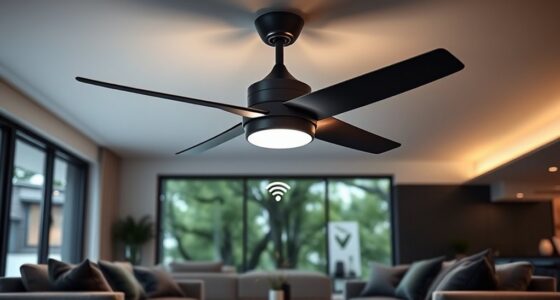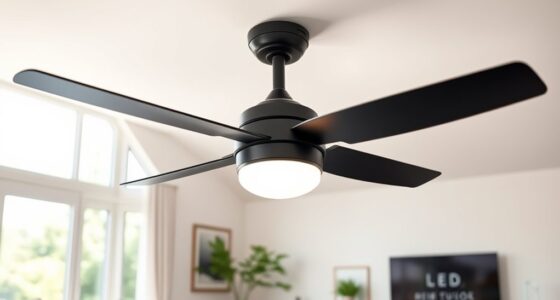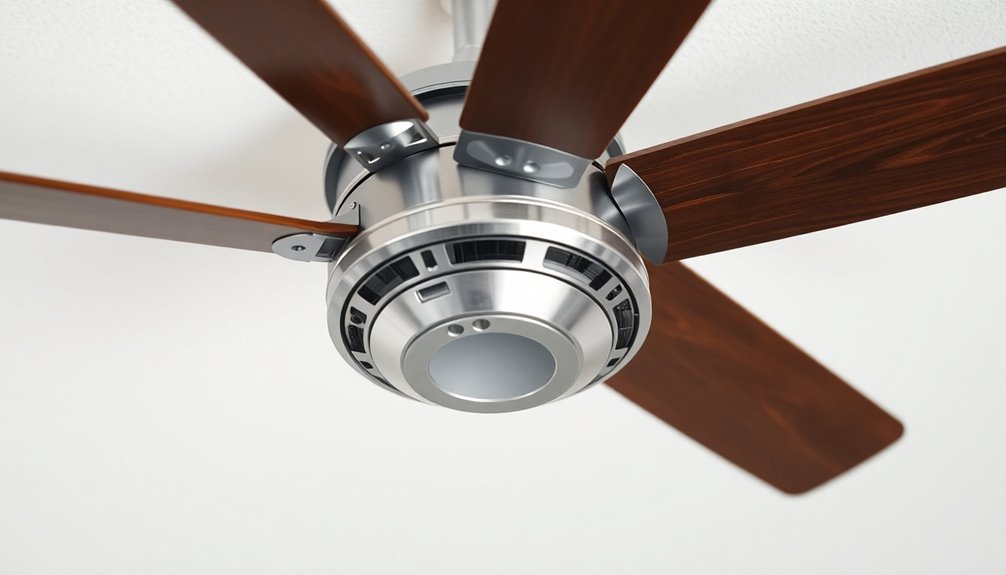You shouldn't change a ceiling fan without turning off the power. It's risky and can lead to serious electrical shock. Live wires can deliver a dangerous current, potentially causing injury or even death. Always prioritize safety by shutting off the circuit breaker before you start any work. Use a voltage tester to guarantee no electricity is flowing, and wear appropriate safety gear. If you're not sure how to proceed, consider getting professional help for installation and safety assurance. Stick around, and you'll discover some essential tips to keep your ceiling fan in great shape.
Key Takeaways
- It is highly dangerous to change a ceiling fan without turning off the power at the circuit breaker first.
- Electrical shock can occur from live wires, potentially causing severe injury or death.
- Using a voltage tester is essential to confirm that no electricity is flowing before starting any work.
- Familiarity with local electrical codes and safety regulations is crucial for safe maintenance practices.
- Hiring a professional ensures compliance with safety standards and reduces the risk of accidents.
Importance of Power Safety
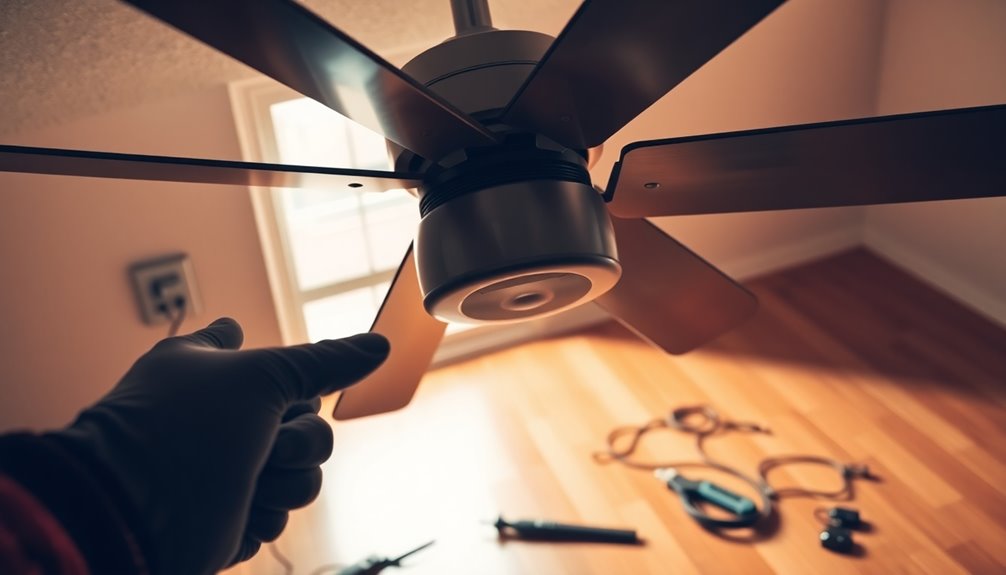
When it comes to changing a ceiling fan, prioritizing power safety is non-negotiable. You need to start by turning off the power at the circuit breaker. Simply turning off the wall switch mightn't eliminate all electrical current in the circuit, which can lead to dangerous situations.
Before you start any work, grab a voltage tester to confirm there's no electricity flowing through the wires. This step is essential in preventing electrical shock, which accounts for about 30,000 injuries annually in the U.S.
Additionally, take precautions like wearing rubber-soled shoes and making sure your work area is dry; these simple measures can greatly reduce your risk of an electrical shock while you're handling the ceiling fan.
It's also important to familiarize yourself with local electrical codes and regulations, as this knowledge guarantees compliance and enhances your safety when dealing with wiring and connections.
Risks of Electrical Shock

Even with the best safety precautions in place, changing a ceiling fan without turning off the power exposes you to serious risks of electrical shock. Live wires can carry enough electrical current to cause severe injury or even death. Each year, around 30,000 injuries from electric shocks are reported in the U.S., highlighting how dangerous working with live electrical fixtures can be.
When you touch a live wire, your body might complete an electrical circuit, allowing current to flow through you. This can happen without you even realizing you're grounded or in contact with another live wire. The consequences of electrical shock can be dire, leading to severe pain, unconsciousness, or burns.
That's why it's essential to follow proper safety measures when working on electrical systems. To minimize risks, always use a voltage tester to confirm that the power is completely off before you touch any electrical components. This simple step can prevent accidents related to inadvertent power restoration and keep you safe while working.
Steps to Disconnect a Fan

To safely disconnect a ceiling fan, you must start by removing the fan blades and any light fixture attached to it. Before you do anything else, make certain you shut off the breaker that controls the fan. Simply turning the switch off mightn't cut all power to the fan, putting you at risk.
After shutting down the circuit, grab a voltage tester to confirm that no electricity is flowing to the fan.
Once you've confirmed the power is off, carefully unscrew and detach the fan's mounting bracket from the ceiling, supporting the fan securely as you work. As you disconnect the wires, label them clearly to help with proper reconnection later. You'll typically find black (hot), white (neutral), and ground wires.
If you encounter any wire nuts during this process, remember to remove them carefully while keeping the wires organized.
With everything disconnected, you can now safely remove the fan from the ceiling. Following these steps will guarantee a safer experience when you disconnect a ceiling fan, while minimizing the risk of electrical shock.
Professional Help for Installation

For many homeowners, seeking professional help for ceiling fan installation is a wise choice. When you're installing a ceiling fan, professionals guarantee the job meets safety standards and complies with electrical codes. They're trained to safely disconnect existing fans and manage the complexities that can arise, especially in older homes with intricate wiring.
By hiring a professional, you greatly reduce the risk of electrical accidents. They'll verify that the power is completely shut off before starting any work, giving you peace of mind. Additionally, many professional services provide warranties on their installations, protecting you against potential issues down the line.
Another benefit of working with professionals is their expertise in selecting energy-efficient fan models. They can recommend fans that not only enhance your comfort but also help lower your energy costs in the long run. Furthermore, they can guide you towards models that align with market trends in ceiling fans, ensuring you choose a fan that is both stylish and functional.
With their specialized tools and knowledge, you can be confident that your new ceiling fan will be installed correctly and function effectively. Ultimately, investing in professional help for your ceiling fan installation is a smart choice that prioritizes safety and efficiency.
Common Ceiling Fan Issues
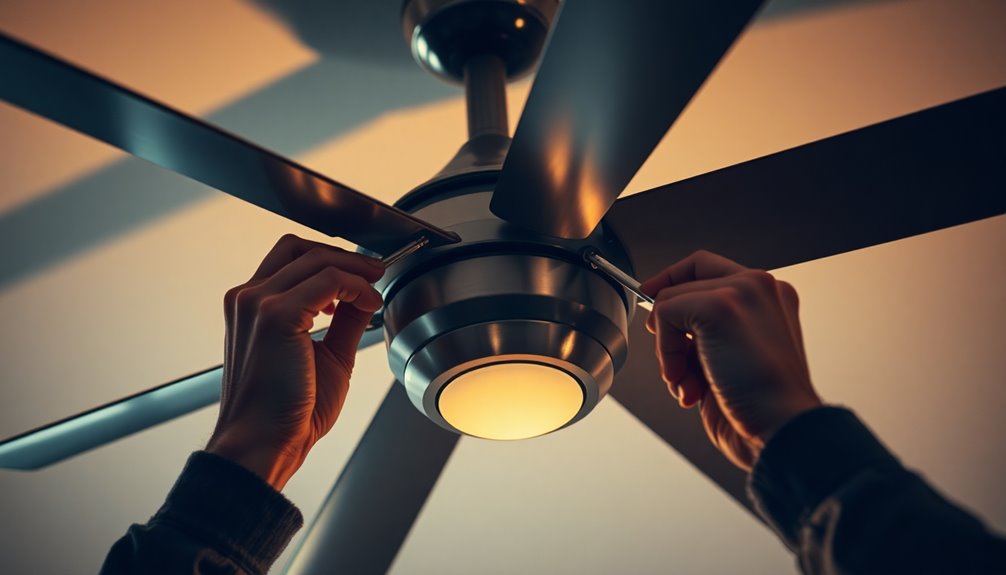
When it comes to ceiling fans, wiring errors, speed control malfunctions, and overloaded circuit breakers are common headaches.
If you're experiencing any of these issues, it's essential to know how to troubleshoot safely. Regular maintenance, including best oils for ceiling fans, can help prevent many of these problems and keep your fan running smoothly.
Wiring Errors and Solutions
Wiring errors can create significant safety hazards and operational issues for ceiling fans. If you attempt to change a ceiling fan without turning off the power, you risk electrical shock from energized circuits. Common wiring mistakes include improper connections of the black (hot), white (neutral), and ground wires, leading to malfunctions or dangerous situations.
To avoid these issues, keep an eye out for:
- Wires that aren't securely connected
- Exposed or frayed wires that can cause shorts
- Reversed polarity between hot and neutral wires
- Loose connections that may overheat
- Incomplete grounding, risking electrical shock
Always use a voltage tester to confirm that power is completely off before starting any work. This guarantees that no part of the circuit is live, even if the switch is turned off.
Additionally, follow local electrical codes to prevent circuit breakers from tripping or worse, fire hazards. Regularly inspect your ceiling fan's wiring connections for wear or damage to maintain safe operation.
Taking these precautions can save you from costly repairs and keep your home safe.
Speed Control Malfunctions
Speed control malfunctions are a common issue that can arise from wiring errors previously discussed, but they can also stem from various mechanical and electrical problems.
If your ceiling fan isn't responding correctly to speed adjustments, check for wiring errors. A fan not connected to the proper circuit can lead to inconsistent speed operation.
Mechanical failures, like a broken pull chain or a damaged capacitor, may hinder your fan's ability to switch speeds effectively. In such cases, repairs or component replacements might be necessary.
Additionally, electrical issues can cause problems; for instance, overloaded circuits might trip circuit breakers, disrupting power to your fan and limiting its operational speeds.
If you use a remote control to adjust your fan's speed, be aware that interference from other devices or weak batteries can lead to inconsistent speed control.
Regular maintenance, including cleaning and lubricating the fan's components, is also essential. It helps prevent speed control issues and guarantees smooth operation over time.
Overloaded Circuit Breakers
Overloaded circuit breakers can be a major headache for ceiling fan users. When multiple high-wattage devices share the same circuit as your ceiling fan, it increases the risk of tripping the breaker. This overload can cause your fan to malfunction, leading to a frustrating experience.
It's essential to recognize the signs of an overloaded circuit:
- Flickering lights when the fan starts
- Frequent tripping of circuit breakers
- Unusual heat near outlets or switches
- A buzzing sound from the fan or wiring
- Inconsistent fan speed or operation
If your ceiling fan isn't working properly, it's likely that the circuit supplying its power is overloaded. Circuit breakers are designed to protect against such issues, but they can only do their job if you turn off the power before you start any work.
Remember, changing a ceiling fan without turning off the power poses a significant risk of electric shock. Always prioritize safety—shut off the circuit breaker to guarantee all wires are de-energized before troubleshooting or replacing your ceiling fan.
This way, you can avoid unnecessary hazards and guarantee a smooth, safe repair process.
Best Practices for Fan Maintenance

To keep your ceiling fan running efficiently, regular blade cleaning is essential. Dust buildup can seriously hinder performance, so make it a habit to wipe down the blades often.
Additionally, inspecting wiring connections every few years can help catch any wear or fraying that could pose safety risks.
Regular Blade Cleaning
Keeping your ceiling fan's blades clean is essential for maintaining peak performance and air quality in your home. Regular cleaning every 1-3 months helps prevent dust and allergens from accumulating, which promotes better air circulation.
Here are some best practices for keeping those blades spotless:
- Use a microfiber cloth or damp cloth with mild detergent for effective cleaning.
- Always turn off the fan before you start to avoid any accidents.
- For hard-to-reach spots, consider a ceiling fan blade cleaner tool designed for easy access.
- Wipe down both the top and bottom of the blades to guarantee thorough cleaning.
- Regular maintenance enhances your fan's efficiency, potentially lowering energy costs.
Inspect Wiring Connections
After confirming your ceiling fan blades are spotless, it's time to focus on the wiring connections, which are vital for safe and efficient operation.
Always turn off the power at the circuit breaker before you start inspecting. Just flipping the wall switch mightn't completely deactivate the power, so this step is essential for your safety.
Next, grab a voltage tester to verify that no electricity is present in the wires. This precaution helps you avoid accidents while you're working.
Before disassembling any connections, carefully document the existing wiring configuration. This record will be invaluable for accurate reinstallation and future troubleshooting.
While inspecting, look for any signs of wear, like frayed insulation or corrosion. Addressing these issues early can prevent electrical hazards and extend your fan's lifespan.
Once you've completed your inspection, confirm all wiring connections are secure and properly insulated with wire nuts or electrical tape. Loose or exposed wires can lead to short circuits or even fire hazards, so take this step seriously.
Regular maintenance of your ceiling fan's wiring connections will keep it running smoothly and safely.
Frequently Asked Questions
Do You Need to Shut off Power to Change a Ceiling Fan?
You definitely need to shut off the power to change a ceiling fan.
It's essential for your safety, as working with live electrical wires can lead to serious injuries. A simple wall switch mightn't fully disconnect the power, so it's best to turn off the circuit breaker.
Always use a voltage tester to verify the power is off before you start.
Prioritizing safety will help prevent accidents and keep you secure while you work.
Can You Change a Light Fixture Without Turning off Power?
You shouldn't change a light fixture without turning off the power. Doing so puts you at risk of electrical shock or short circuits.
Even if the switch is off, circuits can still be energized. Always use a voltage tester to confirm that power is off before starting any work.
Remember, safety comes first, and local codes often require shutting off power for electrical tasks.
It's best to prioritize your safety and follow these guidelines.
How to Change Ceiling Fan Direction Without Switch?
Did you know that changing your ceiling fan's direction can reduce heating costs by up to 10%?
To change the direction without a switch, locate the reverse switch on the fan's motor and toggle it while the fan runs.
If your fan has pull chains, pull them in the right sequence.
For remote-controlled fans, use the reverse button, often marked with an arrow.
Regularly adjusting the direction can enhance comfort and energy efficiency!
Is It Hard to Replace an Existing Ceiling Fan?
Replacing an existing ceiling fan can be a bit challenging, especially if you're not familiar with electrical work.
You'll need to disconnect the power, remove the fan blades, and unmount the fan, which can be tricky. If you're not comfortable with wiring or lack the right tools, it might get overwhelming.
Plus, larger fans can be heavy, so having a second person to help can make the process much easier and safer.
Conclusion
In summary, while it might seem tempting to change a ceiling fan without turning off the power, it's safer to prioritize your well-being. Just like a ship steering through stormy seas, you need to be cautious to avoid potential danger. Power safety is vital, and taking the time to disconnect the fan properly can prevent electrical shocks and accidents. If you're unsure, don't hesitate to call a professional to guarantee a smooth and safe installation.


